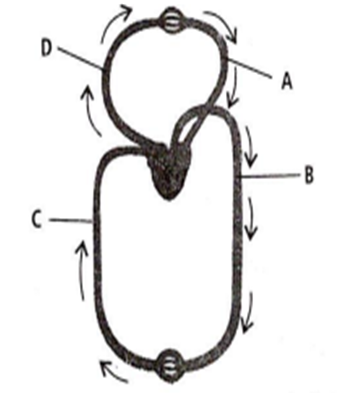 Multiple Choice Questions
Multiple Choice QuestionsWhich of the following are homosporous pteridophytes?
I. Selaginella
II. Lycopodium
III. Salvinia
IV. Equisetum
I and IV only
II and III only
II and IV only
III and IV only
Cornea transplant in humans is almost never rejected. This is because
it is composed of enucleated cells
it is a non-living layer
its cells are least penetrable by bacteria
it has no blood supply
Pseudostratified epithelium is found in
seminiferous tubule
Fallopian tube
trachea
kidney tubules
The given figure shows schematic plan of blood circulation in humans with labels A to D. Identify the labels along with their functions and select the correct option.

C- Vena Cava - takes blood from body parts to right atrium, Pco2 = 45 mm Hg
D- Dorsal aorta - takes blood from heart to body parts, Po2 = 95 mm Hg
A- Pulmonary vein - takes impure blood from body parts to heart, Po2 = 60 mm Hg
B- Pulmonary artery - takes blood from heart to lungs, Po2= 90 mm Hg.
Which one of the following is not a mammalian character?
Presence of milk producing glands
Skin is unique in possessing hair
Presence of external ears called pinnae
Homodont type of dentition
Retrogressive metamorphosis occurs in
Hemichordata
Cephalochordata
Urochordata
Vertebrata
C.
Urochordata
In retrogressive metamorphosis, degeneration is shown by larva to form less developed adult. It is a type of metamorphosis seen in Herdmania (Urochordate). It involves transformation of an active, free swimming larva with advanced characters into sedentary and simple adult.
One hormone hastens maturity period in juvenile conifers, a second hormone controls xylem differentiation, while the third hormone increases the tolerance of plants to various stresses. They are respectively
Gibberellin, Auxin, Ethylene
Auxin, Gibberellin, Cytokinin
Gibberellin, Auxin, ABA
Auxin, Gibberellin, ABA
The H-zone in the skeletal muscle fibre is due to
the central gap between actin filaments extending through myosin filaments in the A-band
extension of myosin filaments in the central portion ofthe A-band
the absence of myofibrils in the central portion of A-band
the central gap between myosin filaments in the A-band.
